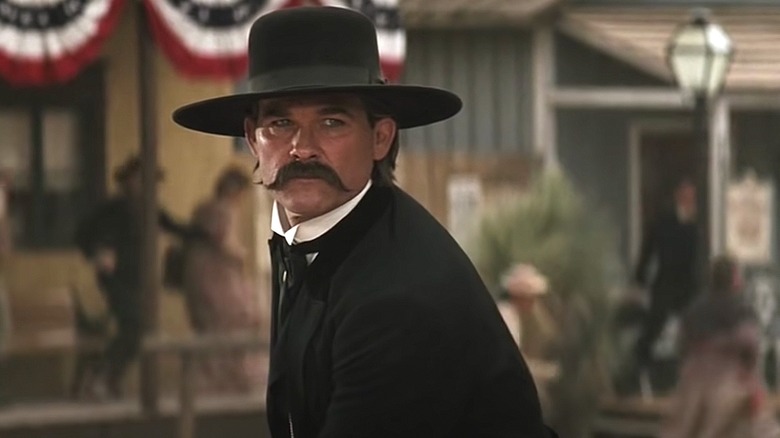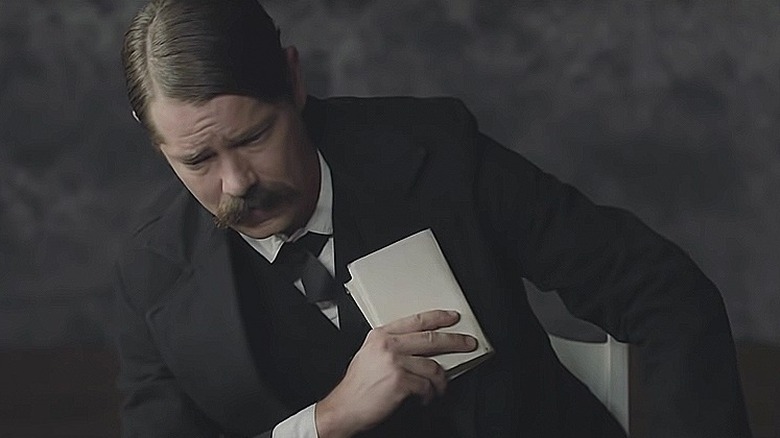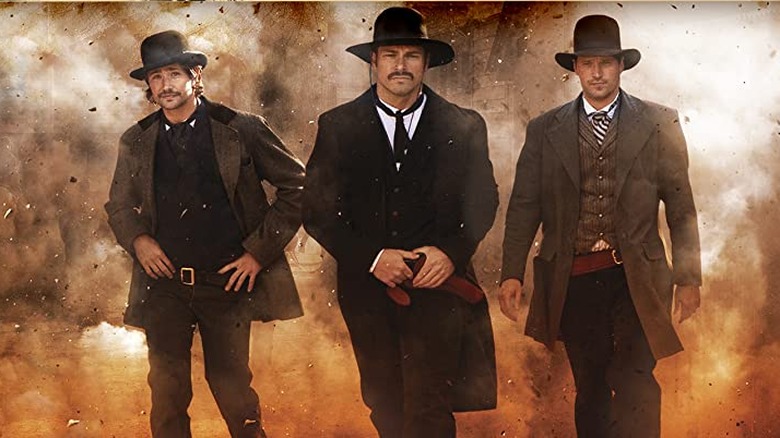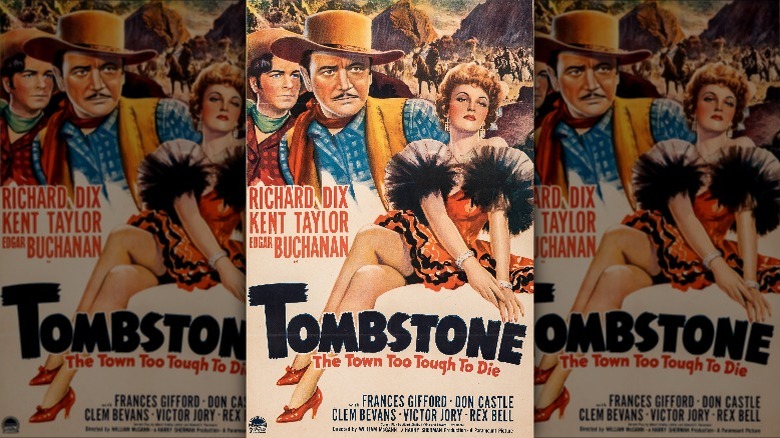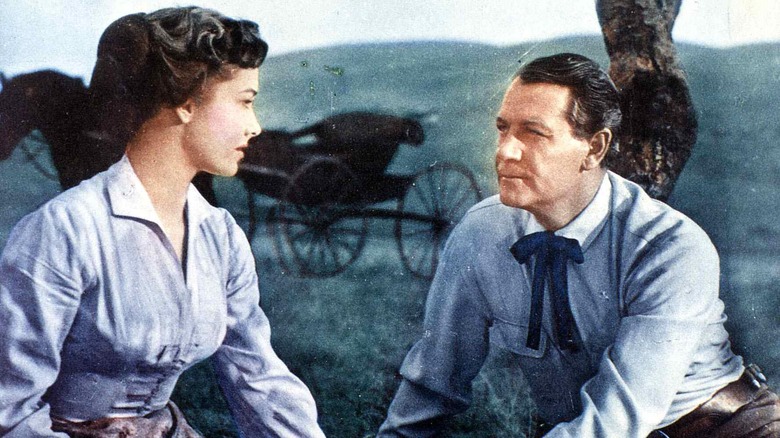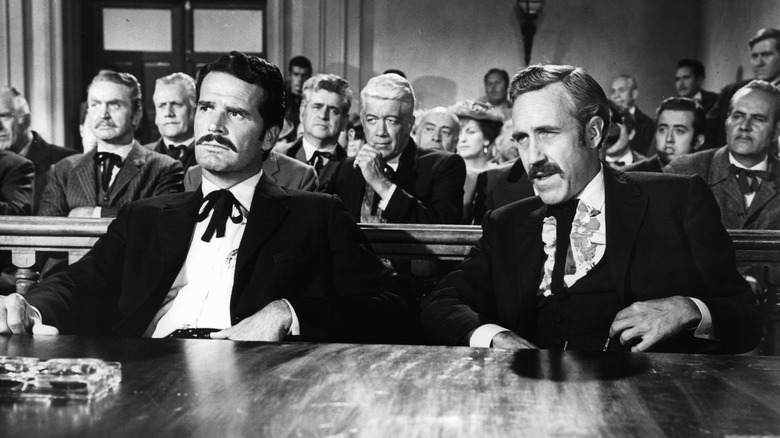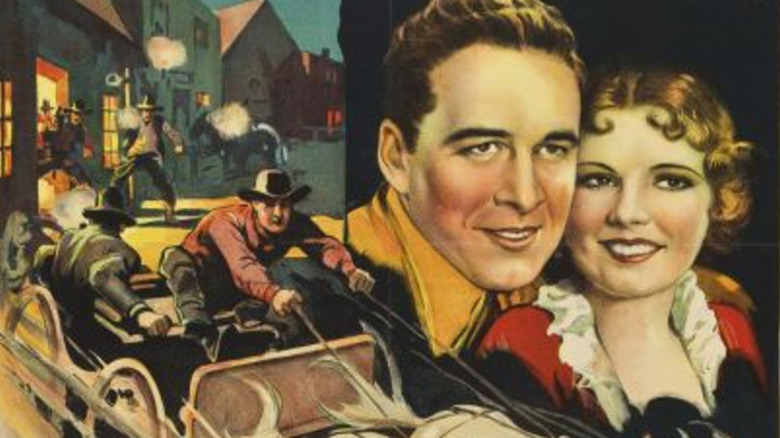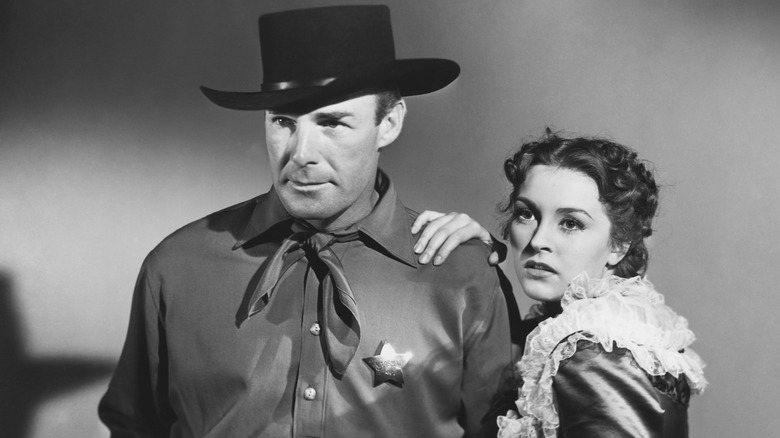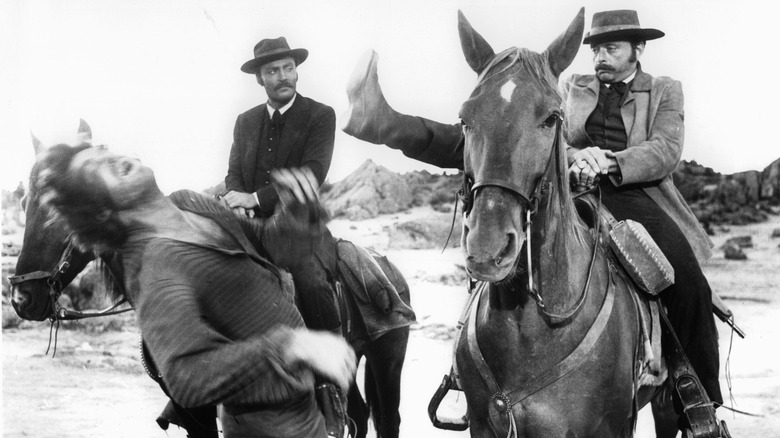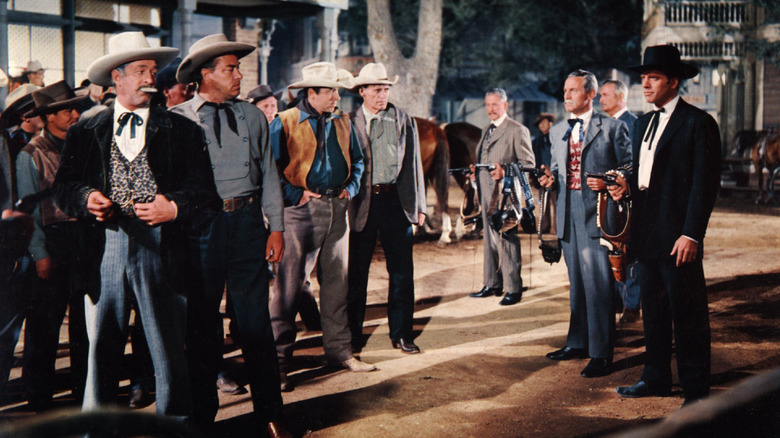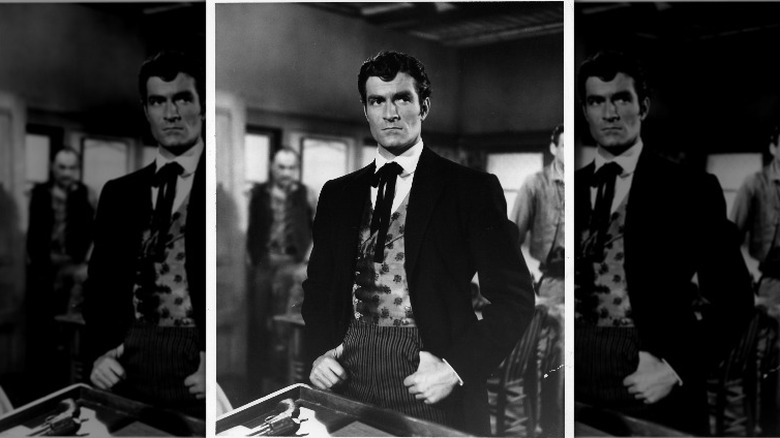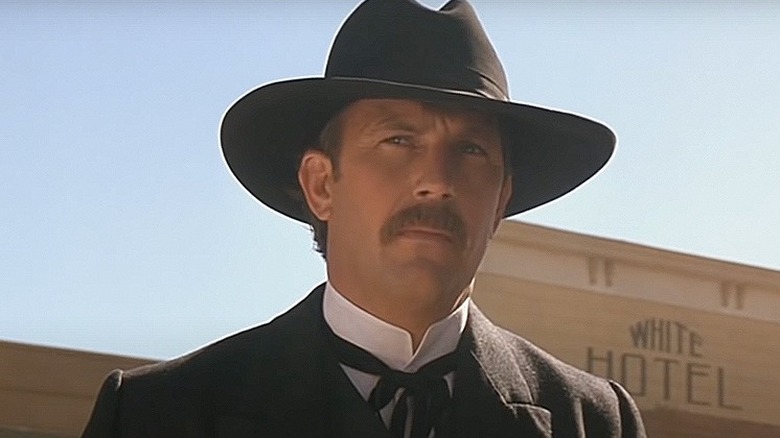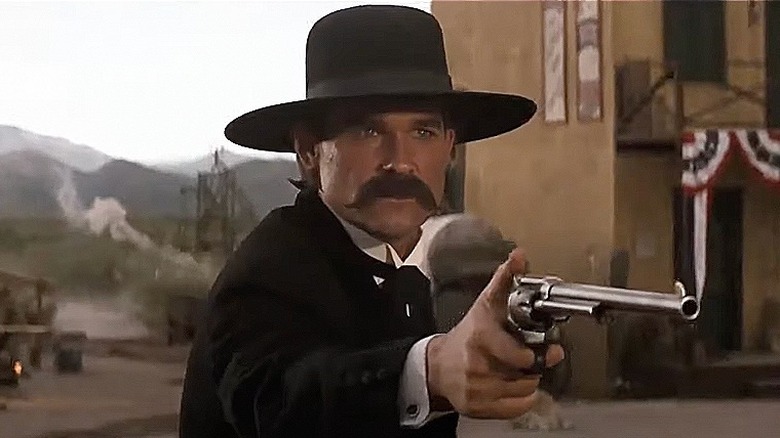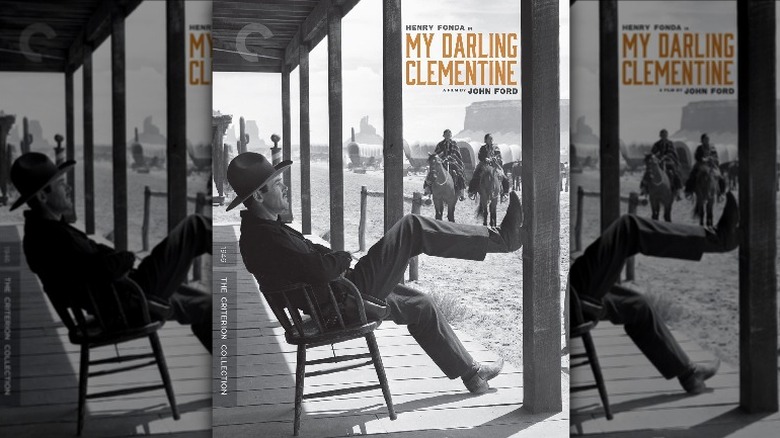13 Best Westerns About Wyatt Earp Ranked
Since the early 1900s, Hollywood has brought many different versions of legendary lawman Wyatt Earp's life to the big screen. Believe it or not, it was a long time before people were interested in his story. According to Mark C. Carnes' book "Past Imperfect: History According to the Movies," after moving to Los Angeles with his wife Josephine, Earp would spend a lot of his time hanging around frontier types who worked as actors on the sets of Hollywood Westerns. He wanted a book or a movie made that would portray him accurately, unlike previous publications that didn't tell the real story. In 1928, Stuart Lake, a magazine and film writer who believed in Earp, visited him and began writing one of the most successful Western biographies of all time: "Wyatt Earp: Frontier Marshal" (1931). Once Lake published the book, it became a success, and people in Hollywood started to see the bigger picture.
Stephen Hunter of The Baltimore Sun wrote, "Contemporary accounts suggest that the real Wyatt had two extraordinary strengths: He was always deadly calm, and he was one of those rare men who was quite literally fearless. He'd just stand there, aim and fire, no matter the lead whizzing in the air. He himself expressed it most eloquently: 'Take your time — fast.'" On our list of the best portrayals of Wyatt Earp, we've taken into account every actor to play the Old West icon as well as the quality and cultural impact of the films that featured him. Here are the most notable portrayals of Wyatt Earp onscreen, ranked from worst to best.
13. Tombstone Rashomon (2017)
In 2017, Alex Cox, writer and director of cult classics such as "Sid and Nancy" and "Repo Man," released "Tombstone Rashomon," a bizarre sci-fi Western about a group of filmmakers who somehow travel back in time and end up at the O.K. Corral after the infamous shootout. Cox borrowed from Akira Kurosawa's 1950 classic "Rashomon," in that the survivors of the gunfight each tell a different version of what happened to the film crew. Cox proved he has a very loyal fan base by having them finance the film using the crowdsourcing platform Indiegogo, reports Huffpost.
When asked about his inspiration for the movie, Cox said: "Oh, I don't really know. I've been thinking about doing the O.K. Corral story for a very long time. I guess it came as a result of seeing 'Rashomon.' Such a good film and such a good way of approaching a story of which there's more than one version. It just seems appropriate. But then you get into a situation where you're trying to raise money for a film called 'Tombstone Rashomon' from the general public — how many people know what 'Rashomon' is? One in a thousand, maybe?"
The film received tepid reviews from the few critics who knew of its existence. Adam Newberry played Wyatt Earp, a performance that took a backseat to the zaniness of the plot and ends up as the worst (and weirdest) portrayal onscreen of the iconic lawman.
12. Wyatt Earp's Revenge (2012)
This is Val Kilmer's second appearance in a Wyatt Earp film, and this time, he's playing the Old West legend himself. The direct-to-video "Wyatt Earp's Revenge" goes back and forth between Wyatt as an older man (Kilmer) and as a younger man, played by Shawn Roberts. While in San Francisco, Wyatt tells a reporter a very vivid and very historically inaccurate tale about how he and his posse of men went after Spike Kenedy, the killer of his lover, Dora Hand.
Some critics referred to Kilmer's performance of an aging Wyatt as "tired" — this was surprisingly one of the better reviews of the movie. And Roberts' younger version of Wyatt is played with one single expression of his face throughout most of the film. One of the highlight performances is that of Wilson Bethel as a young Doc Holliday, whose take on the character is very maniacal, to say the least. One reviewer called the film "boring, predictable, and extremely poor in quality to boot."
11. Tombstone: The Town Too Tough to Die (1942)
Of all the classic Western takes on Earp's story, this remains the least well-known and the least regarded. In the fourth edition of his published film guide, British critic Leslie Halliwell describes the film as a "lacklustre low-budget version of a famous story." That's about all you can find in terms of reviews, old or new. Despite surely thrilling audiences back when Westerns were approaching their peak, the film sits in the shadow of more memorable retellings. For example, John Ford's "My Darling Clementine," considered an all-time classic, would come out just four years later.
The film, aptly titled after the organized town's motto, feels more interested in Tombstone as an ensemble rather than the setting for Earp's life story. The state of Arizona itself narrates the beginning (not kidding) and, at one point, Earp and town newcomer Johnny Duane go around collecting taxes. It's not exactly thrilling. However, if William McGann's Western is fondly remembered for one thing, it's Richard Dix as Wyatt Earp. The star well embodies Earp's calm demeanor and sense of justice, perhaps because he was advised by a personal friend of Earp, Frederick Gildart, who happened to be the film's technical advisor, according to TCM.
10. Wichita (1955)
"Wichita" is director Jacques Tourneur's retelling of the early, pre-Dodge City part of Wyatt Earp's career. The film was notable for being Allied Artists' first release in CinemaScope and (as some consider it) a prequel to John Ford's "My Darling Clementine." According to Great Western Movies, actor Joel McCrea was more popular than John Wayne at the time of filming. McCrea had starred in other Westerns prior to working on the film and was a top choice.
In "Wichita," McCrea plays a young Wyatt Earp with stern morality, opposite Vera Miles' fine performance as Laurie McCoy. Some criticized the casting of McCrea as a young Wyatt because in real life, the actor was 50 years old at the time of filming, and Wyatt was much younger while working as a policeman in Wichita. The Chicago Reader notes that the cast is full of actors from other well-known Westerns, including Lloyd Bridges, Edgar Buchanan, Jack Elam, Walter Sande, Robert Wilke, and Sam Peckinpah in a bit part as a bank teller.
9. Hour of the Gun (1967)
Many consider this to be director John Sturges' best movie. James Garner plays Wyatt Earp, and Jason Robards plays Doc Holliday in the sequel to "Gunfight at the O.K. Corral." "Hour of the Gun" goes into the third act of Wyatt's life, a part not focused on in most movies prior to this film's release. The Wyatt in "Hour of the Gun" is one of Garner's most challenging roles and shows the paranoia and moral decline of the lawman.
The film was ahead of its time and took many risks when it came to its plot and climax, which led to poor reception during its initial release but much more relevance and appreciation many years later, as audiences matured. According to TCM, "The proffering of a fallen king, a hero weakened and ultimately destroyed by desire and revenge, was unprecedented in the sixties Western film genre." AMC notes that Garner would later portray Earp again in 1988, this time as an amateur detective in the TV movie "Sunset."
8. Frontier Marshal (1934)
Stuart Lake sold the rights of his book "Wyatt Earp: Frontier Marshal," to the Fox Film Company for $7,500 and loyally split $6,750 with Wyatt's wife, Josephine Marcus, writes HistoryNet. "Frontier Marshal" was the first movie based on Lake's famous biography that made Wyatt into an American hero. The protagonist, played by George O'Brien, is based on Earp but uses the name Michael Wyatt. O'Brien would later work closely with director John Ford in many movies and became a Navy captain during World War II. Ford would eventually make the Wyatt Earp film "My Darling Clementine" in 1946 and base it off of the second adaptation of "Frontier Marshal."
The first-ever portrayal of Wyatt seen on screen was by Bert Lindley during a very brief scene in the 1923 silent movie "Wild Bill Hickok." While "Frontier Marshal" isn't the best portrayal of Wyatt on screen, it was the first to really show his character and give him credit to his name as the legendary lawman of the Wild West.
7. Frontier Marshal (1939)
Released in 1939, "Frontier Marshal" was the second version of the film of the same name released in 1934. It was also the first movie centered on the life of Wyatt to use his real name. Wyatt was portrayed by actor Randolph Scott. As noted by AMC, Scott's portrayal of Earp in the movie foreshadows his later solitary characters in Budd Boetticher's films. According to Great Western Movies, Scott plays a strong, clean-cut Wyatt Earp who never makes a move on his love interest, Sarah, played by Nancy Gates.
"Frontier Marshal" would later serve as the basis of John Ford's 1946 remake, "My Darling Clementine." The film was known for its ensemble cast and acting that dazzled viewers. Cesar Romero also captures the audience with his dark portrayal of Doc Halliday (as his name is spelled in the movie). "In short, 'Frontier Marshal' is a cracking good Western, and in the movies there's nothing much better than that," writes The New York Times.
6. Doc (1971)
Released in 1971, "Doc" is a unique addition to the film renditions of Wyatt Earp because it made a statement about Vietnam's impact on America. According to historian John Mack Faragher in the book "Past Imperfect: History According to the Movies," Pete Hamill, screenwriter of "Doc," drew a straight line between his script and the Vietnam War. "We were continuing to fight [in Vietnam] because of some peculiar notions of national macho pride," Hamill wrote. "Indochina was Dodge City, and the American [sic] were some collective version of Wyatt Earp." As HistoryNet notes, the film was known for being one of the "dirty" Westerns popular in the early 1970s, presenting a crude, realistic image of dirty, weathered sets and costumes.
The film was also noted for its revisionism and attempt to rewrite the characters fans were used to seeing in previous Wyatt Earp movies. Paul Mavis of DVDTalk described Harris Yulin's version of Wyatt as a "cold-blooded, Nixonian politician who doles out smarmy, unconvincing platitudes about making Tombstone a better place to live for families, all the while plotting and scheming to take over the town and bleed it dry." Stacey Keach does a fine performance as Doc Holliday, and Faye Dunaway's Kate Elder helps light up the screen.
5. Gunfight at the O.K. Corral (1957)
"Gunfight at the O.K. Corral" was John Sturges' first feature film based on Wyatt Earp. Legendary actors Burt Lancaster and Kirk Douglas star as Wyatt Earp and Doc Holliday. According to the Mark C. Carnes-edited book "Past Imperfect: History According to the Movies," the film focused more on the psychology of the relationship between Doc and Earp and stayed closer to historical fact than previous Wyatt screen adaptations. AMC notes that while the cast was brilliant, "the movie's true star will always be the tour de force shoot-out that gives the movie its name. The elaborately staged scene took a reported 44 hours to film (for a mere six minutes of screen time)."
Lancaster's portrayal of Wyatt is considered by some critics as underplayed and reactionary to his supporting cast. When it comes to Kirk Douglas playing Doc Holliday, John G. Nettles of PopMatters writes: "Douglas, on the other hand, is clearly having fun, even if no one else is. The flamboyant Doc Holliday is the Hamlet of the Western, a role with so many layers and shades that whoever plays it inevitably dominates the film."
4. The Life and Legend of Wyatt Earp (1955 - 1961)
"The Life and Legend of Wyatt Earp' was the first adult Western on television and became a top-ten-rated series, reports the LA Times. Actor Hugh O'Brian became a household name and earned Emmy nominations for his portrayal of the O.K. Corral icon. According to True West Magazine, the show also catapulted "the myth of his extra-long-barreled Buntline special." Wyatt Earp biographer Stuart Lake was listed as a consultant for the show. The series followed Wyatt from the first episode, where he becomes marshal of Ellsworth, Kansas, to later episodes, where the lawman moves to Dodge City. According to HistoryNet, "The 'Life and Legend' theme song about brave, courageous and bold Wyatt Earp is ingrained in the minds of many 1950s baby boomers and, indeed, remains as catchy as a goldfish in a glass bowl."
O'Brian took the role seriously and spent lots of time developing the character of Wyatt for the ABC series. One of his proudest achievements as Wyatt was developing the fast draw the lawman was known for. "I didn't want to force them into having to cut away whenever that happened; I wanted it to be realistic," the actor said in a 2005 Archive of American Television interview.
O'Brian spent hundreds of hours practicing the quick draw, which "became a very big promotional tool ... and everybody talked about the quick draw."
3. Wyatt Earp (1994)
Kevin Costner stars as Wyatt Earp in a three-hour-plus biographical film that aims to cover the entirety of Wyatt's life. According to The Morning Call, Costner had approached director Lawrence Kasdan about making a miniseries on Earp. Kasdan turned down the idea of a miniseries and opted to make a full-length film about the Wild West lawman instead.
Kasdan explained the significance of Costner's performance, saying: "To me, great acting is the closest you can get to the truth of the moment. And I don't think there's anyone in the world who understands how to act for a camera better than Kevin Costner does. Wyatt Earp is a major piece of acting from Costner. He goes from real youth and innocence to a tragically earned wisdom. He plays it perfectly, calibrates it just so. And never once begs for your sympathy."
The film was more historically accurate than most others based on Wyatt Earp. According to historian John Mack Faragher in "Past Imperfect: History According to the Movies," Costner claimed his version of Earp was constructed "within the bounds of historical fact." However, many critics complained that the film focused too much on accurately recounting Wyatt's life and not on what made him so iconic. Stephen Hunter of The Baltimore Sun said the film was "a myth in search of a man."
2. Tombstone (1993)
When comparing "Tombstone" to "Wyatt Earp" (released just six months apart), more Western fans and critics have chosen "Tombstone" as the better film. It was indeed a gunslinging showdown between both movies, with "Tombstone" also winning at the box office by earning $56 million, more than double the earnings of "Wyatt Earp." "Tombstone" focused on more than just Wyatt Earp's character, and the film wasn't afraid to take artistic liberties that didn't distract too much from capturing the real Wyatt Earp. The film contained an ensemble cast of Bill Paxton, Sam Elliott, Charlton Heston, Thomas Haden Church, Billy Bob Thornton, and, of course, Val Kilmer's version of Doc Holliday, which is regarded as one of his best roles. The iconic mustache and one-liners were a part of his charm on screen that many remember.
Kurt Russell put a lot of work into the character of Wyatt and even more behind the camera. "I have such admiration for Kurt as he basically sacrificed lots of energy that would have gone into his role, to save the film," Kilmer told The Hollywood Reporter. "Everyone cared, don't get me wrong, but Kurt put his money where his mouth was. He also stated, "I watched Kurt sacrifice his own role and energy to devote himself as a storyteller, even going so far as to draw up shot lists to help our replacement director, George Cosmatos, who came in with only two days prep."
1. My Darling Clementine (1946)
"My Darling Clementine" is one of director John Ford's best films and focuses on Wyatt Earp as he helped restore law and order by bringing civilization to the Wild West. According to Britannica, Ford's classic film helped take Earp from a historical footnote to an American icon and turned the gunfight at the O.K. Corral into the stuff of legend. The screenplay may have been historically inaccurate, but audiences were treated to a masterclass in directing by Ford and a cinema experience that painted a close enough (and incredible) picture of the real Wyatt Earp.
According to Filmsite, Henry Fonda's portrayal of Wyatt shows "his personal life from a scruffy cowpoke in the first scenes to a dignified, well-groomed Marshal that parallels the civilizing of the town of Tombstone — from a rough frontier outpost (with raucous saloons) to a civilized, law and order community settlement (with a church, a school and new schoolmarm, and even a traveling Shakespearean actor)." TCM notes that Ford concentrated on the smaller, mundane moments of Earp's life, such as his visits to the barber or his attraction to the new woman in town. These stylistic choices help explain why Criterion selected the shot of Wyatt casually leaning back on his chair, overseeing the town in a subtle and very concentrated way, for its cover (pictured above). Last but not least, Ford does the iconic shoot-out at the O.K. Corral just right. These are the reasons why we had to go with "My Darling Clementine" as the best Western about Wyatt Earp (so far).
